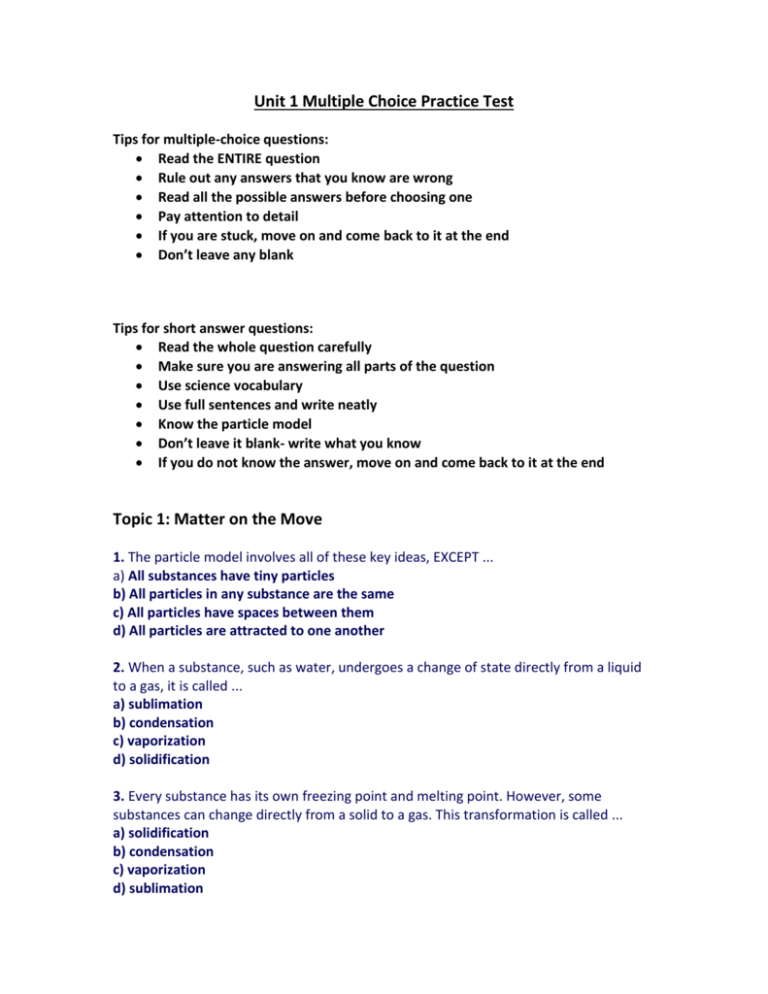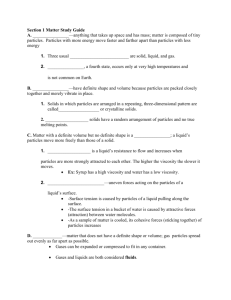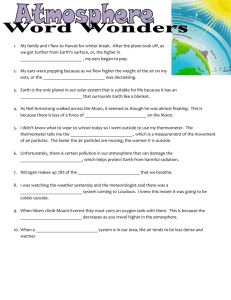Topic 5: Density
advertisement

Unit 1 Multiple Choice Practice Test Tips for multiple-choice questions: Read the ENTIRE question Rule out any answers that you know are wrong Read all the possible answers before choosing one Pay attention to detail If you are stuck, move on and come back to it at the end Don’t leave any blank Tips for short answer questions: Read the whole question carefully Make sure you are answering all parts of the question Use science vocabulary Use full sentences and write neatly Know the particle model Don’t leave it blank- write what you know If you do not know the answer, move on and come back to it at the end Topic 1: Matter on the Move 1. The particle model involves all of these key ideas, EXCEPT ... a) All substances have tiny particles b) All particles in any substance are the same c) All particles have spaces between them d) All particles are attracted to one another 2. When a substance, such as water, undergoes a change of state directly from a liquid to a gas, it is called ... a) sublimation b) condensation c) vaporization d) solidification 3. Every substance has its own freezing point and melting point. However, some substances can change directly from a solid to a gas. This transformation is called ... a) solidification b) condensation c) vaporization d) sublimation Topic 2: Mixing and Dissolving 1. A rock like material appears to be one color - at a distance - but, upon careful examination, it has many different colors. It should be classified as ... a) element b) compound c) homogenous d) heterogenous 2. When a substance, such as sugar, dissolves in water, the particles intermingle. This is possible because the particles of sugar ... a) are pure b) have strong attactions to each other c) have spaces between them d) are vaporized 3. Dissolving can be affected by a number of factors including all of the following, EXCEPT ... a) temperature b) agitation c) pressure d) volume Topic 4: Flow Rate and Viscosity 1. The viscosity of liquids can be compared by observing their ... a) clarity b) volume c) resistance to flow d) resistance to acceleration 2. In order to increase the speed of flow of oil in a pipeline, the oil should be ... a) heated b) cooled c) expanded d) compressed 3. Fluid A has a flow rate of 10. 5 ml, per second. Fluid B has a flow rate of 11. 3 ml, per second. Compared to fluid A, fluid B is ... a) more viscous b) less viscous c) more dense d) less dense Topic 5: Density 1. An everyday situation, like a 'crowded' elevator, can represent the particle model, which helps us to visualize empty spaces between the particles. In this example a 'spacing box' is used in an elevator. Each person has their own individual 'spacing box'. The idea of spaces between the particles, in this example, helps us to understand the concept of density, if we consider ... a) the placement of the spacing boxes in the elevator b) the type of spacing box used c) the size of the spacing box d) the number of spacing boxes 2. The particles in a liquid cannot support the particles of a solid, unless ... a) the liquid is less dense b) the liquid particles have less attractive force between them c) the solid particles have more attractive force between them d) the solid is less dense 3. Which of the following statements best describes the correct difference, in terms of density? a) liquids are less dense than gases b) gases are less dense than liquids c) gases are more dense than solids d) liquids are more dense than solids Topic 6: Buoyancy 1. Your friends collected rocks from a lake to get exercise. They noticed that the rocks weren't as heavy while they carried them partially submerged in the water. This is because of the ... a) mass of the rock b) density of the water c) buoyant force of the water d) buoyant force of the rock 2. Large ocean liners, like the Titanic, can float on the water because ... a) its average density is lower than saltwater b) the metal it was made of is less dense than water c) the metal is more dense and therefore can float d) saltwater is more dense and can hold up steel 3. Archimedes principle states that 'the buoyant force acting on an object equals a) the mass of the fluid displaced by the object b) the force that holds the object afloat c) the weight of the object displaced by the fluid d) the weight of the fluid displaced by the object 4. Archimedes formulated his principle as a result of a very simple test about sinking and floating. He stepped into the bath and he sank, but when he stepped into the boat, on the water, he floated in the boat. The reason for this was because the buoyant force was ... a) less in the water b) less in the boat c) greater in the water d) greater in the boat 5. Density and buoyant force are related. As the ... a) density of a fluid increases, the buoyant force decreases b) density of a fluid decreases, the buoyant force increases c) density of a fluid increases, the buoyant force remains the same d) density of a fluid decreases, the buoyant force decreases Topic 7: Fluid Pressure 1. A gas can be compressed if three conditions are met. They include all of the following EXCEPT ... a) the gas must be at room temperature b) the gas must be in a sealed container c) it will remain a gas even after it has been compressed d) a force is applied to push the particles closer together 2. When a force is applied to a substance and the particles cannot be forced closer together the substance is said to be incompressible. What happens to the force? a) it changes the volume b) it is absorbed by the substance c) it is applied throughout the substance d) it changes direction 3. The atmosphere around the Earth is approximately 160 km thick. It is the force of gravity which keeps it in place. What effect does this layer of air have on us when we hike up a mountain? a) it weighs us down a lot less as we climb b) it weighs us down a lot more as we climb c) it has no effect, because our body is use to it d) it has no effect, because our body can adjust to it 4. When we suck on a straw in a tetrapak juice container, the sides of the container collapse. This happens because ... a) we are increasing the pressure inside the container b) the atmospheric pressure is collapsing the walls of the container c) the pressure inside the container is increased and collapses from the added pressure d) we are lowering the strength of the container when we suck on the straw Topic 8: Fluid Systems 1. Valves are devices used to regulate the flow of a fluid. In an aerosol product such as whipped cream the cream inside the can can be dispersed easily by bending the nozzle. This is possible because the particles always ... a) travel from lower pressure areas b) travel from higher pressure areas c) get more energy when they are released d) make foam when they are released 2. In terms of design, a pneumatic device (such as a compressor) resembles a hydraulic press. The distinguishing difference is that this pneumatic device uses ... a) compressed alcohol b) incompressible fluids c) compressed air d) an electrical current to operate it 3. The primary function of a pump is that it is a device used for ... a) moving fluids b) filtering fluids c) analyzing fluids d) measuring fluids








